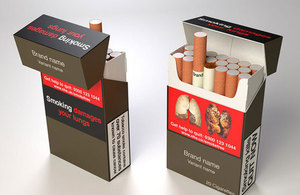Standardised packaging can save lives and boost local economies
Public Health England responds to standardised packaging of tobacco products consultation.

New Public Health England (PHE) figures reveal the potential benefits that standardised packaging of tobacco products could bring, not only for health but in savings of around £500 million – providing a real economic boost to the most deprived communities.
The new figures come following recent official data from Australia, where standardised packaging was introduced in December 2012. Data from the Australian Treasury shows a 3.4% fall in tobacco sales by volume in the first year following the introduction of standardised packs. If that was mirrored here, PHE predicts that total savings across England would be around £500 million.
With tobacco a major cause of health inequalities – the greatest harm being suffered by the most disadvantaged – the benefits would be most felt in areas of greater social deprivation; not only reducing the devastating harm caused by smoking and boosting health improvement, but also increasing families’ disposable income – money that could be spent on other things providing a real boost to local economies.
Retailers earn relatively little profit from tobacco sales. On average, only 7 to 9% of the cost of tobacco is retained by the retailer, compared to 20 to 30% for food and drink products. Money saved by customers from reduced spending on tobacco is likely to be spent elsewhere locally and benefit local businesses more.
For example, the estimated figures show total savings in a year if standardised packaging was introduced and the potential knock on local economic benefits of:
- £61.3 million in London
- £9.2 million in Birmingham
- £4.4 million in Hull
- £3.3 million in Plymouth
The new evidence from Australia and estimated local economic benefits across England form part of PHE’s response to the Government’s consultation on the introduction of regulations for standardised tobacco packaging. PHE’s response builds on its submission to Sir Cyril Chantler’s review on standardised packaging in January 2014.
Professor Kevin Fenton, National Director of Health and Wellbeing, Public Health England, said:
Smoking remains the biggest cause of premature mortality in England, accounting for 80,000 deaths every year. Standardised packaging is a powerful measure that would help to save lives. The evidence from Australia is adding to the substantial and irrefutable case that the absence of attractive packaging works to reduce the number of smokers, as well as encouraging others to cut down.
The harms from smoking hit hardest in the more deprived communities. Standardised packaging can help us make a real impact on reducing the shocking statistics on health inequalities in England. And in addition, the savings made on tobacco sales will have a knock on benefit to local economies.
Only last week we saw smoking levels among young people at an all-time low. The introduction of standardised packaging will be a major boost to our tobacco control efforts – helping move us closer towards achieving a tobacco free generation, which is now in our reach.
John McClurey, an independent newsagent and member of Gateshead Council, said:
These figures from Public Health England are good news for local businesses. A reduction in tobacco expenditure actually means more money being spent in the local economy. Traders like me are well aware of the tiny profit from tobacco products – I make similar profit from a pack of chewing gum as a £6 pack of cigarettes. What my customers save by quitting or never starting to smoke, they can spend on other goods or services in the area – providing a real boost to the local economy.
Standardised packs would cause no confusion or extra costs for small businesses like mine and frankly, I would much rather sell birthday cards than sympathy cards.
In June 2014, the Department of Health published draft regulations for consultation for proposed requirements for the packaging of cigarettes and hand-rolling tobacco. The regulations include proposed policies on the colour of the packet, allowed text and typeface, and requirements for the appearance of individual cigarettes. The consultation closes on 7 August 2014. Powers to introduce standardised packaging of tobacco products already exist in legislation.
Ends
Notes to Editors
- Methodology for predicted tobacco expenditure savings:
The method involved:
- estimating the number of smokers in each local authority using the smoking prevalence and 18+ population estimates for 2012 and 2013. Note that 2012 smoking prevalence figures have been applied to 2013 population estimates as the 2013 smoking prevalence data is not yet available.
- estimating the number of smokers in UK and therefore each UK nation for 2012 and 2013. Smoking prevalence data for Wales, Scotland and Northern Ireland were obtained from ASH facts - Smoking statistics April 2014
- calculating the proportion of smokers in each English local and unitary authority as a percentage of the total smokers in UK. The total spend of tobacco in the UK for 2012 and 2013 was applied to this proportion to estimate the total spend by smokers for each English local and unitary authority.
- Read the Commonwealth Treasury tobacco clearances data 2013.
- Read the Australian Institute of Health and Welfare. National Drug Strategy Household Survey 2013
- PHE exists to protect and improve the nation’s health and wellbeing, and reduce health inequalities. It does this through advocacy, partnerships, world-class science, knowledge and intelligence, and the delivery of specialist public health services. PHE is an operationally autonomous executive agency of the Department of Health.